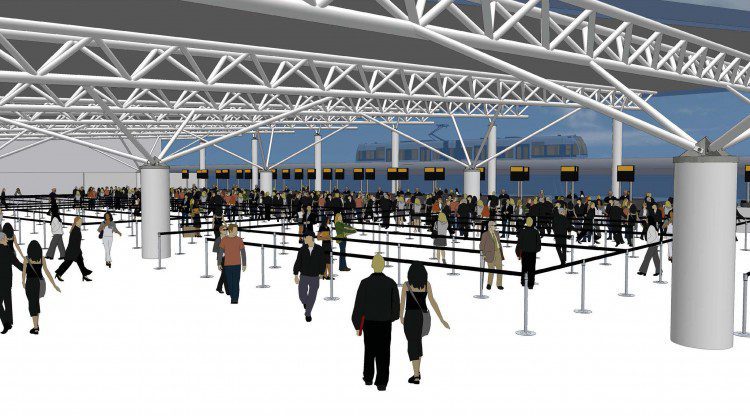
The Port of Seattle is in the conceptual design phase of an expanded International Arrivals Facility (IAF) at Seattle-Tacoma International Airport. With this 1970’s vintage facility in the south satellite servicing a dramatic increase in international flights, the existing Federal Inspections area (commonly known as customs) is beyond its peak capacity. The new IAF is expected to create a higher quality passenger experience, advance the Puget Sound region as a leading tourism and business gateway and serve the traveling public well into the future. It also will help drive the port’s Century Agenda strategy to double the number of international flights and destinations during the next 25 years.
Planned Facility Characteristics
- The IAF will be a new multi-level, 385,000 square-foot facility located east of the current concourse A
- An aerial walkway will connect arriving international passengers from the south satellite across the top of concourse A to the new IAF.
- Creation of a secure international corridor on concourse A will mean more gate positions for arriving international flights with a direct connection to the IAF
- Increase passenger capacity by nearly 60 percent
- From current peak-hour capacity of 1,200 passengers to 1,900 passengers when complete
- Nearly double the number of existing gates capable of serving international wide-body aircraft from 11 to 18 gates
- Increase Passport Check booths and kiosks by 25 percent (from 30 to 40 booths)
- Increase size and number of bag claim carousels from four to six
- Create a single bag claim process, eliminating the need for international passengers to ride a train to baggage claim
- Create direct access from the IAF to ground transportation at airport drives or garage
- Reduce minimum passenger connection time from 90 to 75 minutes
- Updated budget estimates are set to be reviewed by the Port of Seattle Commission in late 2014.
- The airport made minimal investment in the south satellite and customs area since its 1973 opening
- The current customs process requires double bag handling for passengers, first at the customs inspection area, followed by transit in the satellite train to the main terminal for final bag claim and access to the airport drives.
- This process risks potential loss of market share for Sea-Tac and the region as competitor airports, such as Vancouver, BC, are implementing major capital investments to improve their international connections.
- International passenger activity requiring customs clearance at Sea-Tac grew 71 percent since 2004.
- The 13 new international flights added since 2007 include Paris, Frankfurt, Beijing, Reykjavik, Osaka, Shanghai, Tokyo-Narita, Hong Kong and Dubai.
- There are 178 weekly international flights requiring customs clearance in 2014 versus 135 in 2004, a 31 percent increase.
- Including the use of larger aircraft, more flights and new services, this represents an additional 19,000 weekly seats each way, a 103 percent increase compared to 2004.
- A consultant study estimates each new international route generates $75 million annually in direct and indirect economic impact to the region.
- Congestion becomes a critical problem at Sea-Tac during the mid-day peak period due to aircraft schedules. The mid-day peak scheduled seats increased nearly 150 percent since 2004.
- The peak grew from three wide-body flights in 2004 to seven in 2014 with an additional two anticipated within the next five years.
- On a typical day, 1,500 international passengers now arrive in a single peak hour, creating capacity problems in the current facility. Congestion in the processing areas can force airlines to hold passengers onboard aircraft or increase wait times in the facility corridors.
- Worst case scenarios could see passengers bused from aircraft parking areas to the south satellite for customs inspections.